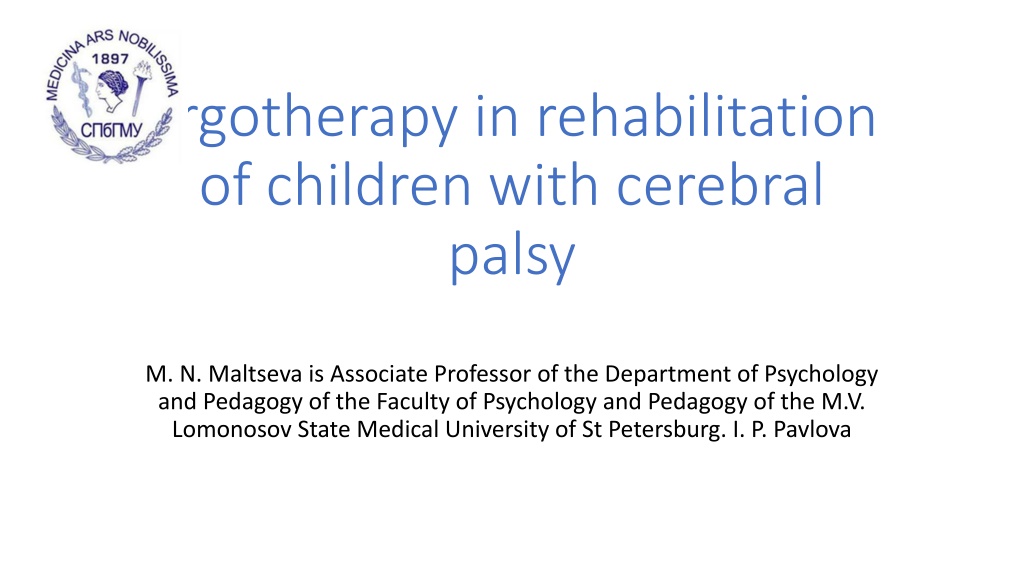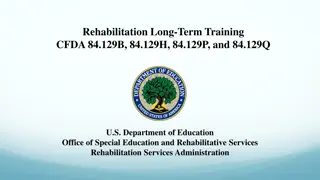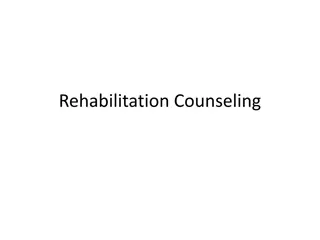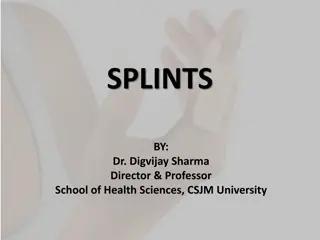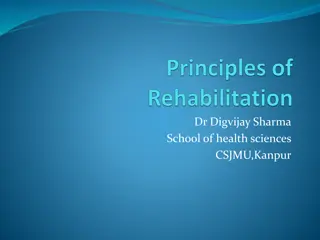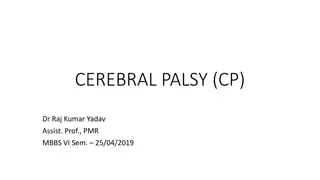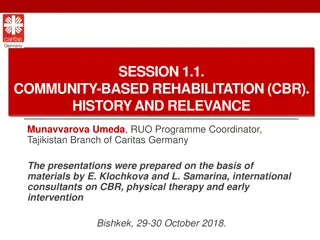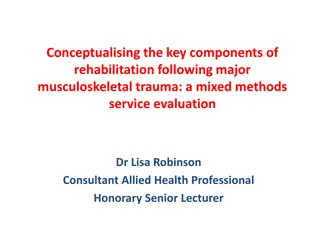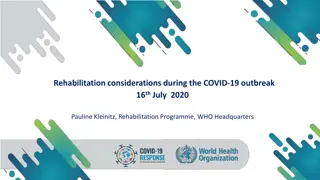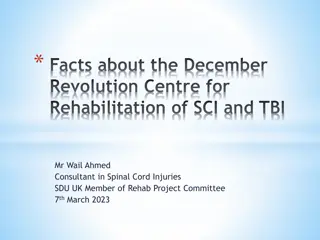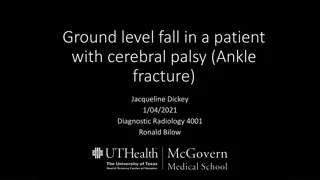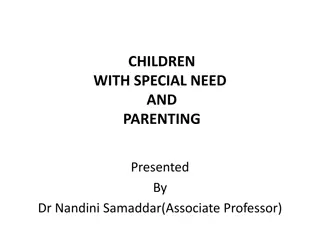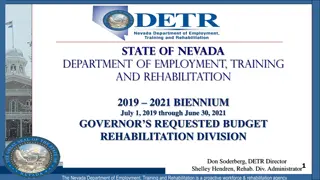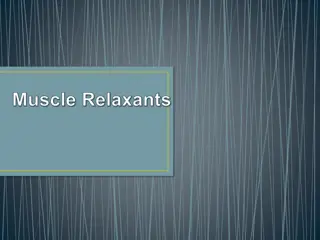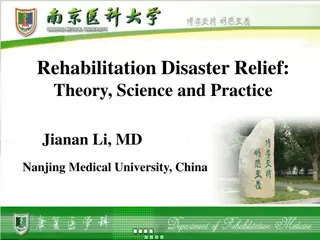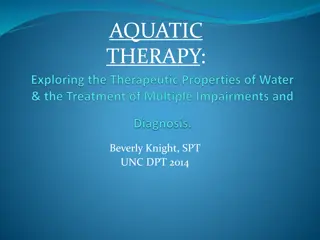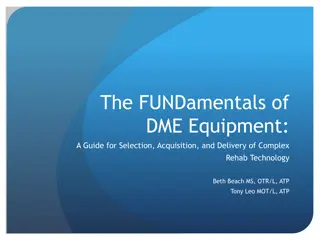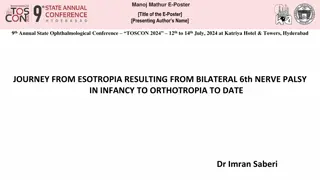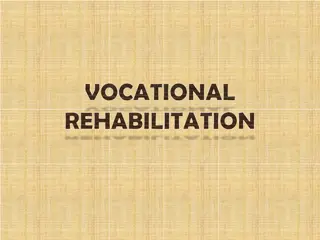Ergotherapy in Cerebral Palsy Rehabilitation
Explore the role of ergotherapy in the rehabilitation of children with cerebral palsy, emphasizing the importance of early habilitation, continuous learning, and support strategies for individuals and families. Discover the challenges faced by parents and caregivers, the necessity for acceptance, and the potential for a fulfilling life despite the lifelong nature of cerebral palsy.
Download Presentation

Please find below an Image/Link to download the presentation.
The content on the website is provided AS IS for your information and personal use only. It may not be sold, licensed, or shared on other websites without obtaining consent from the author.If you encounter any issues during the download, it is possible that the publisher has removed the file from their server.
You are allowed to download the files provided on this website for personal or commercial use, subject to the condition that they are used lawfully. All files are the property of their respective owners.
The content on the website is provided AS IS for your information and personal use only. It may not be sold, licensed, or shared on other websites without obtaining consent from the author.
E N D
Presentation Transcript
Ergotherapy in rehabilitation of children with cerebral palsy M. N. Maltseva is Associate Professor of the Department of Psychology and Pedagogy of the Faculty of Psychology and Pedagogy of the M.V. Lomonosov State Medical University of St Petersburg. I. P. Pavlova
Child cerebral palsy as it is Disability of child from birth Loss of ability to work for one or more relatives Financial expenditure for ongoing support and care Secondary complications and exacerbation of disability Dependence on care and assistance, increasing with age "Locked up life" in an apartment or facility
Children's cerebral palsy as it should be Early habilitation Full early learning of everyday activities (mobility, self-service, hobbies etc) Home and school curricular training Continuing education (college, institute) Continuous adaptation of surroundings to changing needs Continuous selection of technical rehabilitation tools Availability and financial independence as far as possible Full member of society, employee and taxpayer
Ergotherapy in cerebral palsy - support package 0: basic level - teaching that cerebral palsy is for life and that this life has the right to full existence. 1: training relatives in displacement and posture support 2: adaptation of room 3: selection of adaptation and rehabilitation tools 4: choice of therapeutic activity 5: choice of support methods 6: training of relatives in control and support of activities 7: "assessment and plasticity" strategy
Cerebral palsy is for life and this life has the right to a full existence Most parents cannot accept the fact that their child has a disease that is for life. Parents are looking for a medicine or treatment that will cure cerebral palsy in the hope that tomorrow or next year "everything will be cured" and they will have a healthy child. Or they get depressed and look for someone to blame, or wait for it to "disappear". This prevents them from changing their lifestyle, starting habilitation and changing their surroundings and their approach to the child. Parents who have accepted the child's disease and decided to change their life and their child's surroundings eventually get a more independent and fulfilled person in the family, even if walking or speech is impaired. Parents need help along the way.
Family planning Planning the future: how we will teach about leaving home, what will happen in 5 and 10 years with this or that strategy. Planning the present: how to live everyday life so that the child is fully included in it.
Ergotherapy for cerebral palsy, support and movement Typical mistakes - all the activity by the moving person, eventually the child stops trying to move independently. - there is no correction of posture or movement pattern, and over time the child develops pathological postures and movement patterns. - incorrect support (behind the back, behind the shoulders), stability and the ability to "fall forward" for walking do not form - incorrect seating (edge of upholstered furniture, half-lying, hanging etc) Incorrect lying (non-physiological postures, too much lying) Parents need to be trained in walking support, proper planting and fixing, positioning in different positions for the child's different activities.
Adaptation of space and surroundings Spaces should be equipped with handrails, handles, additional devices, furniture and other items that encourage independent activity. Spaces should be redesigned in terms of availability of all parts (lowering of thresholds, change of door handles, inclusion of door closers, change mixer taps, put on toilet attachments etc) The furniture must be adapted to the child's use (height, stability, straps, locks, etc) Toys, dishes and age-appropriate items should be available for the child! We need to think beforehand about going out! Remember that the baby is growing and his/her weight is changing!
Selection of technical resources Up to 70% of secondary complications in cerebral palsy involve subluxation, contracture, spinal curvature etc, and are the result of a poor choice of stroller. An "outgrown" stroller is an additional disability! If too low or too high, the wide backrest causes the spine to curvature. A seat that is too short or too long puts strain on leg muscles and ligaments. Pillars, walker, crutches and strollers should be selected only individually by height and weight, with the specifics of the person's biomechanics taken into account.
Therapeutic activities Playing and teaching a child with cerebral palsy should help develop his/her physical and intellectual abilities. The strategies for developing and compensating the function should complement each other. Activity that is easily completed at the beginning should be replaced tasks of gradually increasing complexity. Teaching should be both inclusive and group-based, involving other children with cerebral palsy, in order to avoid psychological distortions like "I'm different from everyone else".
Support Methods An occupational therapist can not only provide activity therapy, but also include other techniques if necessary. For example, sensory training or kinesiotyping, etc. Also, the ergotherapist should bring in other specialists in good time where needed. For example, a neurologist, speech therapist or physical therapy specialist. Ergotherapy on its own is not sufficient for cerebral palsy.
Training in control and maintenance Parents must learn to constantly monitor the quality of their activities. This is crucial for maintaining interest in activities and stimulating interest in new and complex activities. Do not offer obviously impracticable options, as this will create feelings of helplessness. Do not offer a very simple activity to avoid reducing the child's self- esteem; this will develop a passive life strategy. Do not give in to attempts at manipulation. Encourage the right behaviour and activity.
"Evaluation and plasticity" During growth, therapeutic procedures and habilitation, the child's opportunities, condition and activities change. It is crucial to assess changes regularly and change the environment, means of adaptation and rehabilitation accordingly; it is crucial to make the child's activities more complex. The surroundings should support and stimulate the development of children with cerebral palsy. Modern scales of large, small motor skills and postures need to be used in the evaluation, in order to make the task real. For example, you should not teach a level IV GMFCS child to walk. It is useless and cruel to both child and parents. It is important to develop mobility using a stroller as early as possible, before the motivation to move decreases! A child must play and move!
Where is habilitation and rehabilitation? Working with the surroundings gives 50-80% success in habilitation of children with congenital disabilities. The most successful treatments will be "killed" by poorly organized surroundings. The ergotherapist's job is to turn the surroundings from risk factors and barriers into an environment for developing and maintaining activities. This provides 24-hours rehabilitation and is much more effective than massage in "fits and starts" in hospitals.
